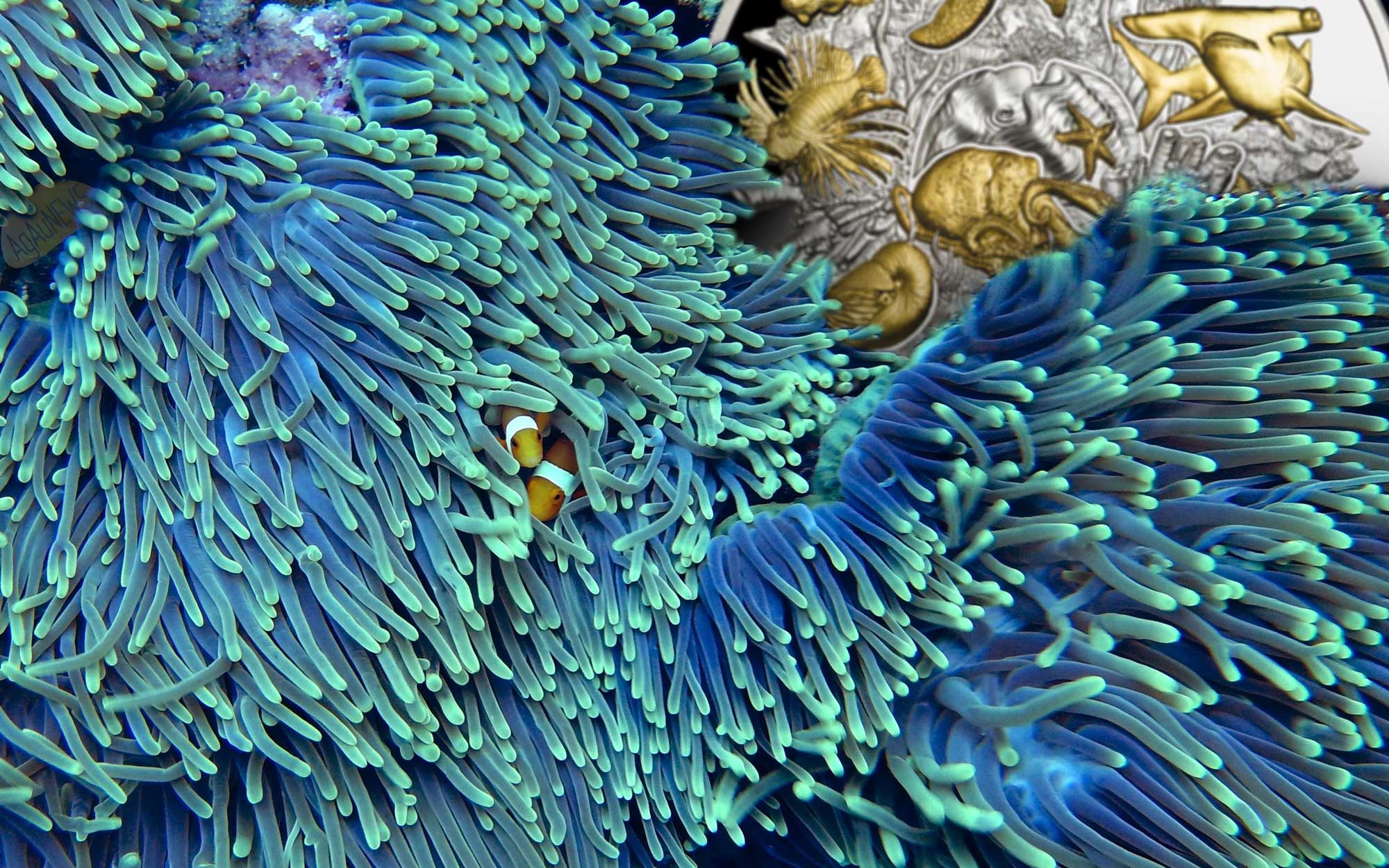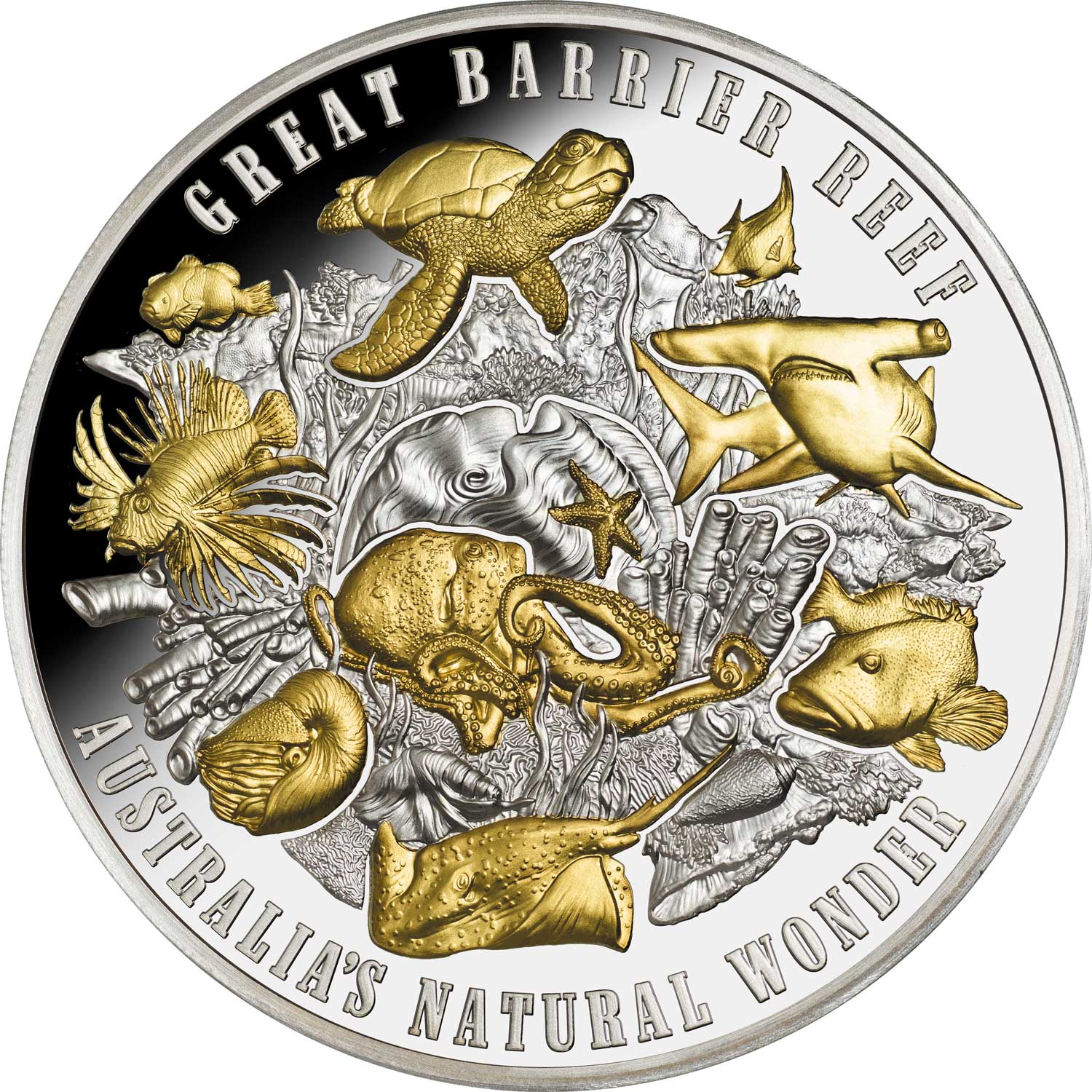Downies takes its five ounce gilded coin format to the Australian Great Barrier Reef
Last year, the Perth Mint issued a five-ounce coin to wrap up their equally popular Stock Horse series by combining multiple small pieces of art – in this case the designs from the five horse issues – to make a single coin. With selective gilding it worked superbly and Downies used the concept to release an Australian Flora & Fauna coin later in the year .Now they’re issuing another coin in the same ilk and it’s an excellent one.
Called Australias Natural Wonder – Great Barrier Reef, the coin portrays a selection of the myriad undersea lifeforms that inhabit this colossal living monument. Ten of the creatures are highlighted with gilding and they sit on a background image that incorporates even more of them, including the reef itself. Keeping the title inscriptions off the main artwork is a nice touch and something we always applaud here. It’s a good looking coin and in our view at least, far superior to the earlier Flora and Fauna effort. It’s all helped by the plus-sized 65mm diameter that gives more intricate designs like this more room to breathe.
The obverse is a bog-standard affair, with the usual Niue effigy of Queen Elizabeth II sitting centrally, surrounded by the coin definitions. Packaging is a wooden box of good quality, if a little dull. A certificate of authenticity is enclosed and it’s all wrapped up in a colourful shipper. It’s a nice concept and much like the Stock Horse version, a fine implementation. One of the better nature coins we’ve seen for a while.
THE GREAT BARRIER REEF
The Great Barrier Reef is the world’s largest coral reef system composed of over 2,900 individual reefs and 900 islands stretching for over 2,300 kilometres and encompassing an area of approximately 344,400 square kilometres. The reef is located in the Coral Sea, off the coast of Queensland, Australia. The Great Barrier Reef can be seen from outer space and is the world’s biggest single structure made by living organisms. This reef structure is composed of and built by billions of tiny organisms, known as coral polyps. It supports a wide diversity of life and was selected as a World Heritage Site in 1981. CNN labelled it one of the seven natural wonders of the world. The Queensland National Trust named it a state icon of Queensland.
The Great Barrier Reef supports a diversity of life, including many vulnerable or endangered species, some of which may be endemic to the reef system. Six species of sea turtles come to the reef to breed: the green sea turtle, leatherback sea turtle, hawksbill turtle, loggerhead sea turtle, flatback turtle, and the Olive Ridley. Fifteen species of seagrass in beds attract the dugongs and turtles, and provide fish habitat.
Thirty species of whales, dolphins, and porpoises have been recorded in the Great Barrier Reef, including the dwarf minke whale, Indo-Pacific humpback dolphin, and the humpback whale. Large populations of dugongs live there. More than 1,500 fish species live on the reef, including the clownfish, red bass, red-throat emperor, and several species of snapper and coral trout. Forty-nine species mass spawn, while eighty-four other species spawn elsewhere in their range. Seventeen species of sea snake live on the Great Barrier Reef in warm waters up to 50 metres deep and are more common in the southern than in the northern section. None found in the Great Barrier Reef World Heritage Area are endemic, nor are any endangered.
Saltwater crocodiles live in mangrove and salt marshes on the coast near the reef. Nesting has not been reported, and the salt water crocodile population in the GBRWHA is wide-ranging but low density. Around 125 species of shark, stingray, skates or chimaera live on the reef. Close to 5,000 species of mollusc have been recorded on the reef, including the giant clam and various nudibranchs and cone snails. Forty-nine species of pipefish and nine species of seahorse have been recorded. At least seven species of frog inhabit the islands. 215 species of birds (including 22 species of seabirds and 32 species of shorebirds) visit the reef or nest or roost on the islands.
Four hundred coral species, both hard corals and soft corals inhabit the reef. The majority of these spawn gametes, breeding in mass spawning events that are triggered by the rising sea temperatures of spring and summer, the lunar cycle, and the diurnal cycle. Reefs in the inner Great Barrier Reef spawn during the week after the full moon in October, while the outer reefs spawn in November and December.
| SPECIFICATION | |
| DENOMINATION | $10 New Zealand |
| COMPOSITION | 0.999 silver |
| WEIGHT | 155.5 grams |
| DIAMETER | 65.00 mm |
| FINISH | Proof |
| MODIFICATIONS | Gilding |
| MINTAGE | 500 |
| BOX / COA | Yes / Yes |





Leave A Comment